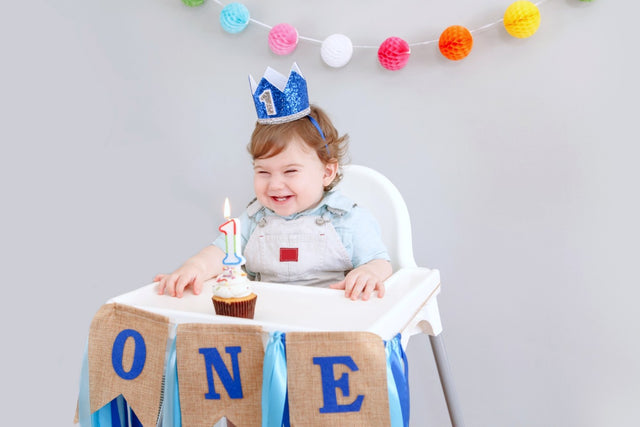12-Month-Old Baby Milestones

Happy birthday, Baby! One whole year of magical firsts—from first smiles to first “Ma-ma”, you’ve packed a lifetime of memories into just 12 months. They call the first year “the longest shortest time” for good reason: Those early sleepless days may seem like they drag on forever. But in retrospect, most parents feel that they’re gone in the blink of an eye.
At 1 year, your baby’s personality, interests, and opinions are on full display. Whether your baby is fiercely independent or one who is happiest sticking close by your side, they will start wanting to make some decisions for themselves.
A good way to encourage this type of independence—within reason—is to offer simple options to guide their choices (think red shoes vs. blue shoes). Options let little kids feel heard and respected. Theo goal is to try to find win-win solutions when you can!
With your parenting feet firmly beneath you by now, you’ve probably learned that no parent has all the answers. Your real goal is to be willing to learn, grow, admit mistakes and do the best you can. Don’t strive for perfect—perfection is only found in the dictionary! You are doing amazingly well. Remember, parents in every culture and throughout all time usually had four to five family members helping them!
Your 12-Month-Old Baby’s Development
A (Sort of) Social Creature
When your baby is comfortable and at ease (read: at home with familiar people), they act one way. When they are in a strange new setting, they may act cautious and shy. That’s totally normal. In fact, it’s a sign that your child has a healthy psychological attachment with you.
Nevertheless, if your tot is anxious around strangers, you can help lessen that by giving them the space to warm up slowly. A little lovey, like a stuffed animal, pacifier, or blanket, can also do wonders for self-soothing. Psychologists call these “transitional objects” because they’re a first friend outside of the family and before they make their first real buddy.
Here are a few tips for having fun and success with loveys…
- Different kids love different sensations. For some, the ideal lovey is a handkerchief-sized silky blanket or hand-sized stuffed animal. Others love bigger cuddle toys, and some are most reassured by their pacifier. (In my practice, one 3-year-old was very attached to a plastic version of Captain Hook’s hook.) Just make sure there are no small pieces, such as button eyes or bead fillings.
- Before introducing the lovey, you should hold it for an hour or two so it picks up your scent. This can be very soothing for your little one!
- Once you find something that works, get two to three of them and alternate their use. Rotating the lovey every week or two gives them all a familiar smell and feel and that way you can keep the lovey clean and there is always a back-up in case it gets forgotten at Grandma’s.
What About Playtime?
While many babies are cautious or nervous around new adults, they may have a completely different take on other babies. One-year-olds are usually fascinated by other little kids. Of course, even though they get very excited watching, they’re not quite ready to join the team. The most common type of play at this age is solitary play. Next up will be spectator play—where tots observe their playmates in action—and then parallel play, where toddlers play alongside each other without really playing together. Usually associate play (aka truly playing together) won’t come until closer to 2 to 3 years.
Your 12-Month-Old Baby’s Health
Gross Motor Milestones at 12 Months
Whether crawling, walking, or running, your 12-month-old baby should be able to zip around pretty well these days…which means you’re on your toes, too! On top of that, your baby may show a real knack for climbing on top of things, so be sure to keep that in mind with your babyproofing.
Although watching your baby scale a couch or chair may get your heart racing, this milestone should be cheered. Not only does climbing show development with their gross motor skills and coordination, but it’s also evidence of their impressive spatial awareness, problem-solving abilities, and motor-planning skills.
Help your mini-mountain-climber practice climbing in a safe environment by signing up for a toddler gymnastics class or by buying foam climbing blocks. At home, you will have to patiently teach your tot what they can and cannot climb on. It may take a few tries, but if you’re consistent they’ll get the message. Tip: In a safe environment, gently nudge your child to put them a bit off balance as they climb. That helps your little one practice getting off-balance and then steadying themselves.
Tips for the 1-Year Checkup
After one year of regular appointments, you should hopefully have a pretty good rapport with your baby’s medical advisor. Good doctors and nurse practitioners make you feel good about your parenting and that your questions are all smart and important. If that’s not the case, you might consider asking your friends for another recommendation.
With your baby’s first birthday comes another well-baby visit. Your doctor will:
- Measure your baby’s weight, length, and head circumference and show where your child is on the growth chart and how their growth has progressed.
- Perform a physical exam to gauge your baby’s strength and development and determine if there are any developmental concerns.
- Give some vaccinations for measles, mumps, rubella (MMR), varicella (VAR), and hepatitis A (HepA).